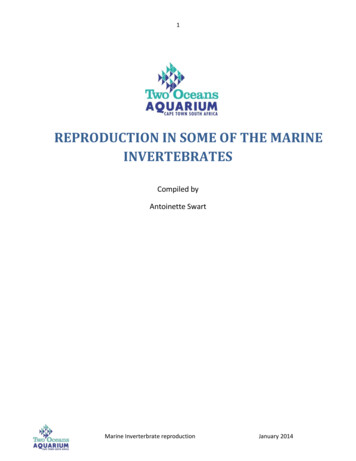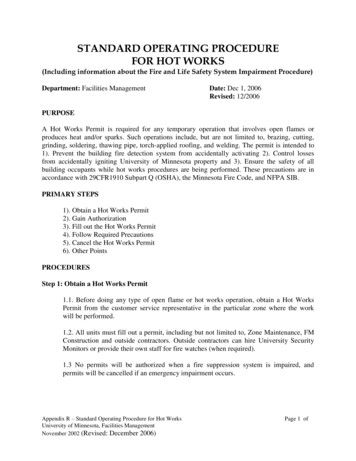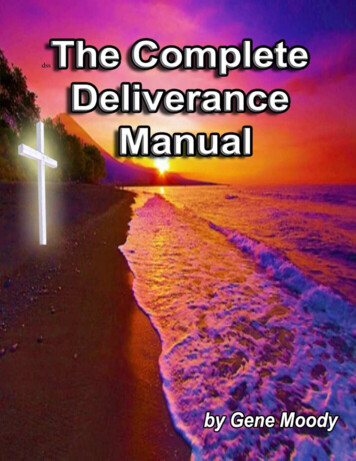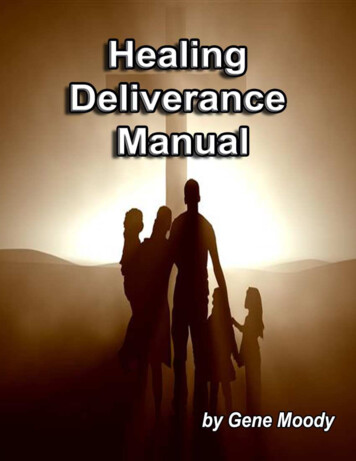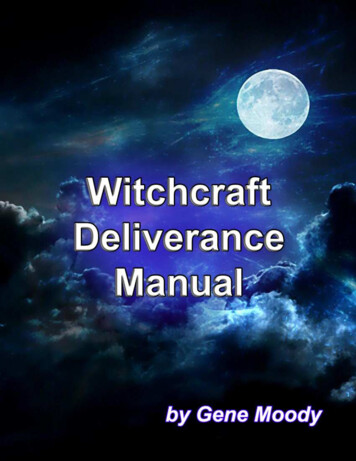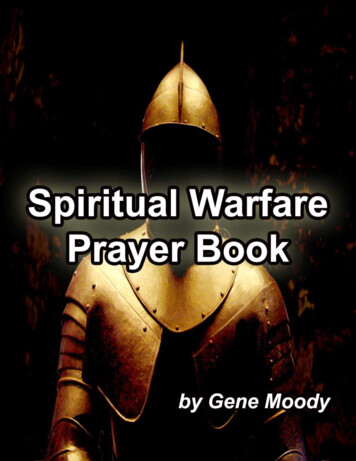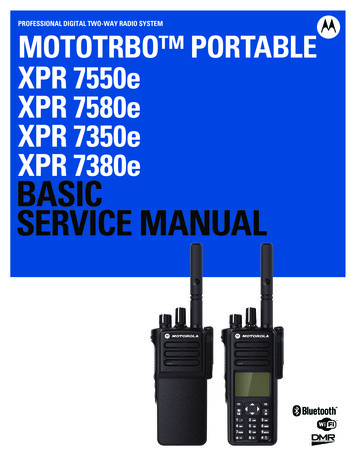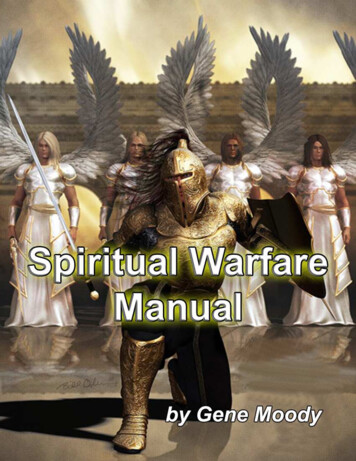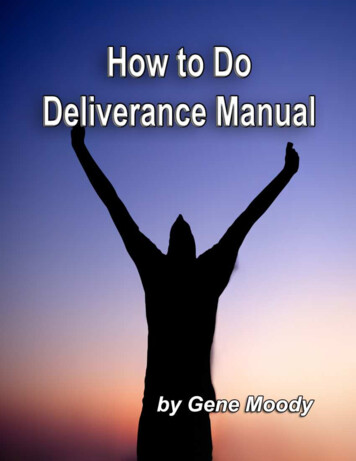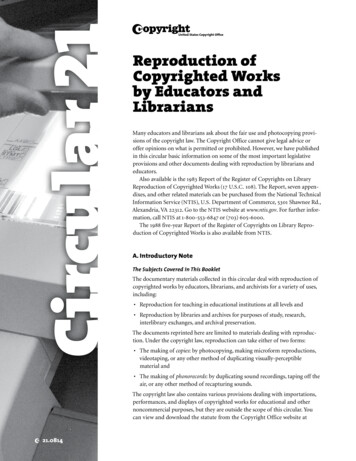
Transcription
Circular 21wReproduction ofCopyrighted Worksby Educators andLibrariansMany educators and librarians ask about the fair use and photocopying provisions of the copyright law. The Copyright Office cannot give legal advice oroffer opinions on what is permitted or prohibited. However, we have publishedin this circular basic information on some of the most important legislativeprovisions and other documents dealing with reproduction by librarians andeducators.Also available is the 1983 Report of the Register of Copyrights on LibraryReproduction of Copyrighted Works (17 U.S.C. 108). The Report, seven appendixes, and other related materials can be purchased from the National TechnicalInformation Service (NTIS), U.S. Department of Commerce, 5301 Shawnee Rd.,Alexandria, VA 22312. Go to the NTIS website at www.ntis.gov. For further information, call NTIS at 1-800-553-6847 or (703) 605-6000.The 1988 five-year Report of the Register of Copyrights on Library Reproduction of Copyrighted Works is also available from NTIS.A. I ntroductory NoteThe Subjects Covered in This BookletThe documentary materials collected in this circular deal with reproduction ofcopyrighted works by educators, librarians, and archivists for a variety of uses,including: Reproduction for teaching in educational institutions at all levels and Reproduction by libraries and archives for purposes of study, research,interlibrary exchanges, and archival preservation.The documents reprinted here are limited to materials dealing with reproduction. Under the copyright law, reproduction can take either of two forms: The making of copies: by photocopying, making microform reproductions,videotaping, or any other method of duplicating visually-perceptiblematerial and The making of phonorecords: by duplicating sound recordings, taping off theair, or any other method of recapturing sounds.The copyright law also contains various provisions dealing with importations,performances, and displays of copyrighted works for educational and othernoncommercial purposes, but they are outside the scope of this circular. Youcan view and download the statute from the Copyright Office website at2 21.0814
Reproduction of Copyrighted Works · 2www.loc.gov. To purchase a copy, go to http://bookstore.gpo.govand search for Circular 92. For information about specificprovisions, write to:Library of CongressCopyright Office-COPUBS101 Independence Avenue SEWashington, DC 20559-6304A Note on the Documents ReprintedThe documentary materials in this booklet are reprints orexcerpts from six sources:1 The Copyright Act of October 19, 1976. This is the copyright law of the United States, effective January 1, 1978(title 17 of the United States Code, Public Law 94-553, 90Stat. 2541).2 The Senate Report. This is the 1975 report of the SenateJudiciary Committee on S. 22, the Senate version of thebill that became the Copyright Act of 1976 (S. Rep. No.94-473, 94th Cong., 1st Sess., November 20 (legislative dayNovember 18, 1975)).3 The House Report. This is the 1976 report of the Houseof Representatives Judiciary Committee on the Houseamendments to the bill that became the Copyright Act of1976 (H.R. Rep. No. 94-1476, 94th Cong., 2d Sess., September 3, 1976).4 The Conference Report. This is the 1976 report of the“committee of conference on the disagreeing votes ofthe two Houses on the amendments of the House to thebill (S. 22) for the general revision of the Copyright Law”(H.R. Rep. No. 94-1733, 94th Cong., 2d Sess., September29, 1976).5 The Congressional Debates. This booklet containsexcerpts from the Congressional Record of September 22,1976, reflecting statements on the floor of Congress at thetime the bill was passed by the House of Representatives(122 Cong. Rec. H 10874-76, daily edition, September 22,1976).6 Copyright Office Regulations. These are regulationsissued by the Copyright Office under section 108 dealing with warnings of copyright for use by libraries andarchives (37 Code of Federal Regulations §201.14).Items 2 and 3 on this list—the 1975 Senate Report andthe 1976 House Report—present special problems. On manypoints the language of these two reports is identical or closelysimilar. However, the two reports were written at differenttimes, by committees of different Houses of Congress, onsomewhat different bills. As a result, the discussions on someprovisions of the bills vary widely, and on certain points theydisagree.The disagreements between the Senate and House versions of the bill itself were resolved when the Act of 1976was finally passed. However, many of the disagreements asto matters of interpretation between statements in the 1975Senate Report and in the 1976 House Report were left partlyor wholly unresolved. It is therefore difficult in compiling abooklet such as this to decide in some cases what to includeand what to leave out.The House Report was written later than the SenateReport, and in many cases it adopted the language of theSenate Report, updating it and conforming it to the versionof the bill that was finally enacted into law. Thus, where thedifferences between the two Reports are relatively minor, orwhere the discussion in the House Report appears to havesuperseded the discussion of the same point in the SenateReport, we have used the House Report as the source of ourdocumentation. In other cases we have included excerptsfrom both discussions in an effort to present the legislativehistory as fully and fairly as possible. Anyone making a thorough study of the Act of 1976 as it affects librarians and educators should not rely exclusively on the excerpts reprintedhere but should go back to the primary documentary sources.B. Exclusive Rights in Copyrighted Works1. Text of Section 106note: The following is a reprint of the entire text of section106 of title 17, United States Code, as amended in 1995 and 2002.§ 106 · Exclusive rights in copyrighted worksSubject to sections 107 through 122, the owner of copyrightunder this title has the exclusive rights to do and to authorizeany of the following:(1) to reproduce the copyrighted work in copies orphonorecords;(2) to prepare derivative works based upon the copyrightedwork;(3) to distribute copies or phonorecords of the copyrightedwork to the public by sale or other transfer of ownership,or by rental, lease, or lending;(4) in the case of literary, musical, dramatic, and choreographic works, pantomimes, and motion pictures and
Reproduction of Copyrighted Works · 3other audio visual works, to perform the copyrightedwork publicly;(5) in the case of literary, musical, dramatic, and choreographic works, pantomimes, and pictorial, graphic, orsculptural works, including the individual images of amotion picture or other audiovisual work, to display thecopyrighted work publicly; and(6) in the case of sound recordings, to perform the copyrighted work publicly by means of a digital audio transmission.2. Excerpts from House Report on Section 106note: The following excerpts are reprinted from the HouseReport on the new copyright law (H.R. Rep. No. 94-1476, pages61–62). The text of the corresponding Senate Report (S. Rep.No. 94-473, pages 57–58) is substantially the same.Section 106. Exclusive Rights in Copyrighted WorksGeneral scope of copyrightThe five fundamental rights that the bill gives to copyrightowners—the exclusive rights of reproduction, adaptation,publication, performance, and display—are stated generallyin section 106. These exclusive rights, which comprise the socalled “bundle of rights” that is a copyright, are cumulativeand may overlap in some cases. Each of the five enumeratedrights may be subdivided indefinitely and, as discussed belowin connection with section 201, each subdivision of an exclusive right may be owned and enforced separately.The approach of the bill is to set forth the copyright owner’s exclusive rights in broad terms in section 106, and thento provide various limitations, qualifications, or exemptionsin the 12 sections that follow. Thus, everything in section 106is made “subject to sections 107 through 118,” and must beread in conjunction with those provisions.***at once, as where a publisher reproduces, adapts, and sellscopies of a person’s copyrighted work as part of a publishingventure. Infringement takes place when any one of the rightsis violated: where, for example, a printer reproduces copieswithout selling them or a retailer sells copies without havinganything to do with their reproduction. The references to“copies or phonorecords,” although in the plural, are intendedhere and throughout the bill to include the singular (1 U.S.C. §1).Reproduction.—Read together with the relevant definitions in section 101, the right “to reproduce the copyrightedwork in copies or phonorecords” means the right to produce a material object in which the work is duplicated,transcribed, imitated, or simulated in a fixed form fromwhich it can be “perceived, reproduced, or otherwise communicated, either directly or with the aid of a machine ordevice.” As under the present law, a copyrighted work wouldbe infringed by reproducing it in whole or in any substantialpart, and by duplicating it exactly or by imitation or simulation. Wide departures or variations from the copyrightedwork would still be an infringement as long as the author’s“expression” rather than merely the author’s “ideas” are taken.An exception to this general principle, applicable to thereproduction of copyrighted sound recordings, is specifiedin section 114.“Reproduction” under clause (1) of section 106 is to bedistinguished from “display” under clause (5). For a work tobe “reproduced,” its fixation in tangible form must be “sufficiently permanent or stable to permit it to be perceived,reproduced, or otherwise communicated for a period ofmore than transitory duration.” Thus, the showing of imageson a screen or tube would not be a violation of clause (1),although it might come within the scope of clause (5).C. Fair Use1. Text of Section 107note: The following is a reprint of the entire text of section107 of title 17, United States Code as amended in 1990 and 1992.Rights of reproduction, adaptation, and publication§ 107 · Limitations on exclusive rights: Fair useThe first three clauses of section 106, which cover all rightsunder a copyright except those of performance and display,extend to every kind of copyrighted work. The exclusiverights encompassed by these clauses, though closely related,are independent; they can generally be characterized asrights of copying, recording, adaptation, and publishing. Asingle act of infringement may violate all of these rightsNotwithstanding the provisions of sections 106 and 106a,the fair use of a copyrighted work, including such use byreproduction in copies or phonorecords or by any othermeans specified by that section, for purposes such as criticism, comment, news reporting, teaching (including multiplecopies for classroom use), scholarship, or research, is not aninfringement of copyright. In determining whether the use
Reproduction of Copyrighted Works · 4made of a work in any particular case is a fair use the factorsto be considered shall include —(1) the purpose and character of the use, including whethersuch use is of a commercial nature or is for nonprofiteducational purposes;(2) the nature of the copyrighted work;(3) the amount and substantiality of the portion used inrelation to the copyrighted work as a whole; and(4) the effect of the use upon the potential market for orvalue of the copyrighted work.The fact that a work is unpublished shall not itself bar afinding of fair use if such finding is made upon consideration of all the above factors.2. Excerpts from House Report on Section 107note: The following excerpts are reprinted from the HouseReport on the new copyright law (H.R. Rep. No. 94-1476, pages65–74). The discussion of section 107 appears at pages 61–67of the Senate Report (S. Rep. No. 94-473). The text of this sec-tion of the Senate Report is not reprinted in this booklet, butsimilarities and differences between the House and SenateReports on particular points will be noted below.a. House Report: Introductory Discussion on Section 107note: The first two paragraphs in this portion of the HouseReport are closely similar to the Senate Report. The remainderof the passage differs substantially in the two Reports.Section 107. Fair UseGeneral background of the problemThe judicial doctrine of fair use, one of the most importantand well-established limitations on the exclusive right ofcopyright owners, would be given express statutory recognition for the first time in section 107. The claim thata defendant’s acts constituted a fair use rather than aninfringement has been raised as a defense in innumerablecopyright actions over the years, and there is ample case lawrecognizing the existence of the doctrine and applying it.The examples enumerated at page 24 of the Register’s 1961Report, while by no means exhaustive, give some idea of thesort of activities the courts might regard as fair use under thecircumstances: “quotation of excerpts in a review or criticismfor purposes of illustration or comment; quotation of shortpassages in a scholarly or technical work, for illustration orclarification of the author’s observations; use in a parody ofsome of the content of the work parodied; summary of anaddress or article, with brief quotations, in a news report;reproduction by a library of a portion of a work to replacepart of a damaged copy; reproduction by a teacher or student of a small part of a work to illustrate a lesson; reproduction of a work in legislative or judicial proceedings orreports; incidental and fortuitous reproduction, in a newsreelor broadcast, of a work located in the scene of an event beingreported.”Although the courts have considered and ruled upon thefair use doctrine over and over again, no real definition ofthe concept has ever emerged. Indeed, since the doctrine isan equitable rule of reason, no generally applicable definition is possible, and each case raising the question must bedecided on its own facts. On the other hand, the courts haveevolved a set of criteria which, though in no case definitive or determinative, provide some gauge for balancingthe equities. These criteria have been stated in various ways,but essentially they can all be reduced to the four standardswhich have been adopted in section 107: “(1) the purpose andcharacter of the use, including whether such use is of a commercial nature or is for non-profit educational purposes; (2)the nature of the copyrighted work; (3) the amount and substantiality of the portion used in relation to the copyrightedwork as a whole; and (4) the effect of the use upon the potential market for or value of the copyrighted work.”These criteria are relevant in determining whether thebasic doctrine of fair use, as stated in the first sentence ofsection 107, applies in a particular case: “Notwithstandingthe provisions of section 106, the fair use of a copyrightedwork, including such use by reproduction in copies orphonorecords or by any other means specified by that section, for purposes such as criticism, comment, news reporting, teaching (including multiple copies for classroom use),scholarship, or research, is not an infringement of copyright.”The specific wording of section 107 as it now stands isthe result of a process of accretion, resulting from the longcontroversy over the related problems of fair use and thereproduction (mostly by photocopying) of copyrightedmaterial for educational and scholarly purposes. For example, the reference to fair use “by reproduction in copies orphonorecords or by any other means” is mainly intendedto make clear that the doctrine has as much application tophotocopying and taping as to older forms of use; it is notintended to give these kinds of reproduction any specialstatus under the fair use provision or to sanction any reproduction beyond the normal and reasonable limits of fair use.
Reproduction of Copyrighted Works · 5Similarly, the newly-added reference to “multiple copies forclassroom use” is a recognition that, under the proper circumstances of fairness, the doctrine can be applied to reproductions of multiple copies for the members of a class.The Committee has amended the first of the criteria tobe considered—“the purpose and character of the use”—to state explicitly that this factor includes a considerationof “whether such use is of a commercial nature or is fornon-profit educational purposes.” This amendment is notintended to be interpreted as any sort of not-for-profitlimitation on educational uses of copyrighted works. It isan express recognition that, as under the present law, thecommercial or non-profit character of an activity, whilenot conclusive with respect to fair use, can and should beweighed along with other factors in fair use decisions.General intention behind the provisionThe statement of the fair use doctrine in section 107 offerssome guidance to users in determining when the principlesof the doctrine apply. However, the endless variety of situations and combinations of circumstances that can rise in particular cases precludes the formulation of exact rules in thestatute. The bill endorses the purpose and general scope ofthe judicial doctrine of fair use, but there is no disposition tofreeze the doctrine in the statute, especially during a periodof rapid technological change. Beyond a very broad statutory explanation of what fair use is and some of the criteriaapplicable to it, the courts must be free to adapt the doctrineto particular situations on a case-by-case basis. Section 107is intended to restate the present judicial doctrine of fair use,not to change, narrow, or enlarge it in any way.b. House Report: Statement of Intention as toClassroom Reproductionnote: The House Report differs substantially from the SenateReport on this point.(i) Introductory StatementIntention as to classroom reproductionAlthough the works and uses to which the doctrine of fairuse is applicable are as broad as the copyright law itself, mostof the discussion of section 107 has centered around questions of classroom reproduction, particularly photocopying.The arguments on the question are summarized at pp. 30–31of this Committee’s 1967 report (H.R. Rep. No. 83, 90thCong., 1st Sess.), and have not changed materially in theintervening years.The Committee also adheres to its earlier conclusion, that“a specific exemption freeing certain reproductions of copyrighted works for educational and scholarly purposes fromcopyright control is not justified.” At the same time the Committee recognizes, as it did in 1967, that there is a “need forgreater certainty and protection for teachers.” In an effort tomeet this need the Committee has not only adopted furtheramendments to section 107, but has also amended section504(c) to provide innocent teachers and other non-profitusers of copyrighted material with broad insulation againstunwarranted liability for infringement. The latter amendments are discussed below in connection with Chapter 5 ofthe bill.In 1967 the Committee also sought to approach this problem by including, in its report, a very thorough discussion of“the considerations lying behind the four criteria listed in theamended section 107, in the context of typical classroom situations arising today.” This discussion appeared on pp. 32–35of the 1967 report, and with some changes has been retainedin the Senate report on S. 22 (S. Rep. No. 94-473, pp. 63–65).The Committee has reviewed this discussion, and considersthat it still has value as an analysis of various aspects of theproblem.At the Judiciary Subcommittee hearings in June 1975,Chairman Kastenmeier and other members urged the parties to meet together independently in an effort to achieve ameeting of the minds as to permissible educational uses ofcopyrighted material. The response to these suggestions waspositive, and a number of meetings of three groups, dealingrespectively with classroom, reproduction of printed material, music, and audio-visual material, were held beginningin September 1975.(ii) Guidelines with Respect to Books and PeriodicalsIn a joint letter to Chairman Kastenmeier, dated March 19,1976, the representatives of the Ad Hoc Committee of Educational Institutions and Organizations on Copyright LawRevision, and of the Authors League of America, Inc., andthe Association of American Publishers, Inc., stated:You may remember that in our letter of March 8, 1976 wetold you that the negotiating teams representing authorsand publishers and the Ad Hoc Group had reached tentative agreement on guidelines to insert in the CommitteeReport covering educational copying from books andperiodicals under Section 107 of H.R. 2223 and S. 22, andthat as part of that tentative agreement each side wouldaccept the amendments to Sections 107 and 504 whichwere adopted by your Subcommittee on March 3, 1976.
Reproduction of Copyrighted Works · 6We are now happy to tell you that the agreement hasbeen approved by the principals and we enclose a copyherewith. We had originally intended to translate theagreement into language suitable for inclusion in thelegislative report dealing with Section 107, but we havesince been advised by committee staff that this will not benecessary.As stated above, the agreement refers only to copying frombooks and periodicals, and it is not intended to apply tomusical or audiovisual works.II. Multiple Copies for Classroom UseMultiple copies (not to exceed in any event more than onecopy per pupil in a course) may be made by or for theteacher giving the course for classroom use or discussion;provided that:a The copying meets the tests of brevity and spontaneity as defined below and,b Meets the cumulative effect test as defined belowand,c Each copy includes a notice of copyrightThe full text of the agreement is as follows:Agreement on Guidelines for Classroom Copyingin Not-For-Profit Educational Institutionswith respect to books and periodicalsThe purpose of the following guidelines is to state the minimum and not the maximum standards of educational fairuse under Section 107 of H.R. 2223. The parties agree thatthe conditions determining the extent of permissible copying for educational purposes may change in the future; thatcertain types of copying permitted under these guidelinesmay not be permissible in the future; and conversely that inthe future other types of copying not permitted under theseguidelines may be permissible under revised guidelines.Moreover, the following statement of guidelines is notintended to limit the types of copying permitted under thestandards of fair use under judicial decision and which arestated in Section 107 of the Copyright Revision Bill. Theremay be instances in which copying which does not fallwithin the guidelines stated below may nonetheless be permitted under the criteria of fair use.GuidelinesI. Single Copying for TeachersA single copy may be made of any of the following by orfor a teacher at his or her individual request for his or herscholarly research or use in teaching or preparation to teacha class:a A chapter from a bookb An article from a periodical or newspaperc A short story, short essay or short poem, whether ornot from a collective workd A chart, graph, diagram, drawing, cartoon orpicture from a book, periodical, or newspaperDefinitionsBrevityi Poetry: (a) A complete poem if less than 250 words and ifprinted on not more than two pages or, (b) from a longerpoem, an excerpt of not more than 250 words.ii Prose: (a) Either a complete article, story or essay of lessthan 2,500 words, or (b) an excerpt from any prose workof not more than 1,000 words or 10% of the work, whichever is less, but in any event a minimum of 500 words.[Each of the numerical limits stated in “i” and “ii” abovemay be expanded to permit the completion of an unfinished line of a poem or of an unfinished prose paragraph.]iii Illustration: One chart, graph, diagram, drawing, cartoonor picture per book or per periodical issue.iv “Special” works: Certain works in poetry, prose or in “poeticprose” which often combine language with illustrationsand which are intended sometimes for children and atother times for a more general audience fall short of 2,500words in their entirety. Paragraph “ii” above notwithstanding such “special works” may not be reproduced intheir entirety; however, an excerpt comprising not morethan two of the published pages of such special work andcontaining not more than ten percent of the words foundin the text thereof, may be reproduced.Spontaneityi The copying is at the instance and inspiration ofthe individual teacher, andii The inspiration and decision to use the work and themoment of its use for maximum teaching effectivenessare so close in time that it would be unreasonable toexpect a timely reply to a request for permission.
Reproduction of Copyrighted Works · 7Cumulative Effecti The copying of the material is for only one course in theschool in which the copies are made.ii Not more than one short poem, article, story, essay or twoexcerpts may be copied from the same author, nor morethan three from the same collective work or periodicalvolume during one class term.iii There shall not be more than nine instances of such mul-tiple copying for one course during one class term.[The limitations stated in “ii” and “iii” above shall notapply to current news periodicals and newspapers andcurrent news sections of other periodicals.]III. Prohibitions as to I and II AboveNotwithstanding any of the above, the following shall beprohibited:a Copying shall not be used to create or to replace or substitute for anthologies, compilations or collective works.Such replacement or substitution may occur whethercopies of various works or excerpts therefrom are accumulated or reproduced and used separately.b There shall be no copying of or from works intended tobe “consumable” in the course of study or of teaching.These include workbooks, exercises, standardized testsand test booklets and answer sheets and like consumablematerial.c Copying shall not:a substitute for the purchase of books, publishers’reprints or periodicals;b be directed by higher authority;c be repeated with respect to the same item by thesame teacher from term to term.d No charge shall be made to the student beyond the actualcost of the photocopying.Agreed March 19, 1976.Ad Hoc Committee on Copyright Law Revision:By Sheldon Elliott Steinbach.Author-Publisher Group:Authors League of America:By Irwin Karp, Counsel.Association of American Publishers, Inc.:By Alexander C. Hoffman,Chairman, Copyright Committee.(iii) Guidelines with Respect to MusicIn a joint letter dated April 30, 1976, representatives of theMusic Publishers’ Association of the United States, Inc., theNational Music Publishers’ Association, Inc., the MusicTeachers National Association, the Music Educators NationalConference, the National Association of Schools of Music,and the Ad Hoc Committee on Copyright Law Revision,wrote to Chairman Kastenmeier as follows:During the hearings on H.R. 2223 in June 1975, you andseveral of your subcommittee members suggested thatconcerned groups should work together in developingguidelines which would be helpful to clarify Section 107of the bill.Representatives of music educators and music publishers delayed their meetings until guidelines had beendeveloped relative to books and periodicals. Shortly afterthat work was completed and those guidelines wereforwarded to your subcommittee, representatives of theundersigned music organizations met together with representatives of the Ad Hoc Committee on Copyright LawRevision to draft guidelines relative to music.We are very pleased to inform you that the discussionsthus have been fruitful on the guidelines which have beendeveloped. Since private music teachers are an importantfactor in music education, due consideration has beengiven to the concerns of that group.We trust that this will be helpful in the report on thebill to clarify Fair Use as it applies to music.The text of the guidelines accompanying this letter is as follows:Guidelines for Educational Uses of MusicThe purpose of the following guidelines is to state the minimum and not the maximum standards of educational fairuse under Section 107 of H.R. 2223. The parties agree thatthe conditions determining the extent of permissible copying for educational purposes may change in the future; thatcertain types of copying permitted under these guidelinesmay not be permissible in the future, and conversely that inthe future other types of copying not permitted under theseguidelines may be permissible under revised guidelines.Moreover, the following statement of guidelines is notintended to limit the types of copying permitted under thestandards of fair use under judicial decision and which arestated in Section 107 of the Copyright Revision Bill. Theremay be instances in which copying which does not fallwithin the guidelines stated below may nonetheless be permitted under the criteria of fair use.
Reproduction of Copyrighted Works · 8a Permissible Uses1 Emergency copying to replace purchased copies whichfor any reason are not available for an imminent performance provided purchased replacement copies shallbe substituted in due course.2 For academic purposes other than performance, singleor multiple copies of excerpts of works may be made,provided that the excerpts do not comprise a part ofthe whole which would constitute a performable unitsuch as a section¹, movement or aria, but in no casemore than 10 percent of the whole work. The numberof copies shall not exceed one copy per pupil.²3 Printed copies which have been purchased may beedited or simplified provided that the fundamentalcharacter of the work is not distorted or the lyrics, ifany, altered or lyrics added if none exist.4 A single copy of recordings of performances by studentsmay be made for evaluation
sculptural works, including the individual images of a motion picture or other audiovisual work, to display the copyrighted work publicly; and (6) in the case of sound recordings, to perform the copy-righted work publicly by means of a digital audio tr
